Gp35/50 mucin molecules of Trypanosoma cruzi metacyclic forms that mediate host cell invasion interact with annexin A2
- PMID: 36190932
- PMCID: PMC9529151
- DOI: 10.1371/journal.pntd.0010788
Gp35/50 mucin molecules of Trypanosoma cruzi metacyclic forms that mediate host cell invasion interact with annexin A2
Abstract
Host cell invasion is a critical step for infection by Trypanosoma cruzi, the agent of Chagas disease. In natural infection, T. cruzi metacyclic trypomastigote (MT) forms establish the first interaction with host cells. The gp35/50 mucin molecules expressed in MT have been implicated in cell invasion process, but the mechanisms involved are not well understood. We performed a series of experiments to elucidate the mode of gp35/50-mediated MT internalization. Comparing two parasite strains from genetically divergent groups, G strain (TcI) and CL strain (TcVI), expressing variant forms of mucins, we demonstrated that G strain mucins participate in MT invasion. Only G strain-derived mucins bound to HeLa cells in a receptor-dependent manner and significantly inhibited G strain MT invasion. CL strain MT internalization was not affected by mucins from either strain. HeLa cell invasion by G strain MT was associated with actin recruitment and did not rely on lysosome mobilization. To examine the involvement of annexin A2, which plays a role in actin dynamic, annexin A2-depleted HeLa cells were generated. Annexin A2-deficient cell lines were significantly more resistant than wild type controls to G strain MT invasion. In a co-immunoprecipitation assay, to check whether annexin A2 might be the receptor for mucins, protein A/G magnetic beads crosslinked with monoclonal antibody to G strain mucins were incubated with detergent extracts of MT and HeLa cells. Binding of gp35/50 mucins to annexin A2 was detected. Both G strain MT and purified mucins induced focal adhesion kinase activation in HeLa cells. By confocal immunofluorescence microscopy, colocalization of invading G strain MT with clathrin was visualized. Inhibition of clathrin-coated vesicle formation reduced parasite internalization. Taken together, our data indicate that gp35/50-mediated MT invasion is accomplished through interaction with host cell annexin A2 and clathrin-dependent endocytosis.
Conflict of interest statement
The authors have declared that no competing interests exist.
Figures




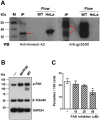
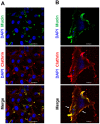
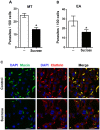
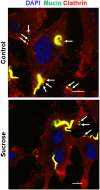
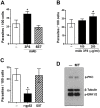

Similar articles
-
Depletion of Host Cell Focal Adhesion Kinase Increases the Susceptibility to Invasion by Trypanosoma cruzi Metacyclic Forms.Front Cell Infect Microbiol. 2019 Jun 26;9:231. doi: 10.3389/fcimb.2019.00231. eCollection 2019. Front Cell Infect Microbiol. 2019. PMID: 31297342 Free PMC article.
-
Inhibition of Host Cell Lysosome Spreading by Trypanosoma cruzi Metacyclic Stage-Specific Surface Molecule gp90 Downregulates Parasite Invasion.Infect Immun. 2017 Aug 18;85(9):e00302-17. doi: 10.1128/IAI.00302-17. Print 2017 Sep. Infect Immun. 2017. PMID: 28607099 Free PMC article.
-
Removal of sialic acid from mucin-like surface molecules of Trypanosoma cruzi metacyclic trypomastigotes enhances parasite-host cell interaction.Mol Biochem Parasitol. 1997 Jan;84(1):57-67. doi: 10.1016/s0166-6851(96)02783-1. Mol Biochem Parasitol. 1997. PMID: 9041521
-
Trypanosoma cruzi infection by oral route: how the interplay between parasite and host components modulates infectivity.Parasitol Int. 2008 Jun;57(2):105-9. doi: 10.1016/j.parint.2007.12.008. Epub 2007 Dec 23. Parasitol Int. 2008. PMID: 18234547 Review.
-
Trypanosoma cruzi: parasite and host cell signaling during the invasion process.Subcell Biochem. 2008;47:82-91. doi: 10.1007/978-0-387-78267-6_6. Subcell Biochem. 2008. PMID: 18512343 Review.
Cited by
-
Annexin A2: the missing piece in the puzzle of pathogen-induced damage.Virulence. 2023 Dec;14(1):2237222. doi: 10.1080/21505594.2023.2237222. Virulence. 2023. PMID: 37482693 Free PMC article. Review.
-
Fifteen Years after the Definition of Trypanosoma cruzi DTUs: What Have We Learned?Life (Basel). 2023 Dec 14;13(12):2339. doi: 10.3390/life13122339. Life (Basel). 2023. PMID: 38137940 Free PMC article. Review.
-
The captivating role of calcium in plant-microbe interaction.Front Plant Sci. 2023 Mar 3;14:1138252. doi: 10.3389/fpls.2023.1138252. eCollection 2023. Front Plant Sci. 2023. PMID: 36938033 Free PMC article. Review.
-
Role of a 49 kDa Trypanosoma cruzi Mucin-Associated Surface Protein (MASP49) during the Infection Process and Identification of a Mammalian Cell Surface Receptor.Pathogens. 2023 Jan 7;12(1):105. doi: 10.3390/pathogens12010105. Pathogens. 2023. PMID: 36678452 Free PMC article.
-
Knockdown of annexin A2 enhances the host cell apoptosis induced by Eimeria tenella.Front Vet Sci. 2025 Jul 24;12:1595384. doi: 10.3389/fvets.2025.1595384. eCollection 2025. Front Vet Sci. 2025. PMID: 40777830 Free PMC article.
References
-
- Hayes MJ, Rescher U, Gerke V, Moss SE. Annexin-Actin interactions [Internet]. Traffic; 2004. pp. 571–576. - PubMed
Publication types
MeSH terms
Substances
LinkOut - more resources
Full Text Sources
Medical

